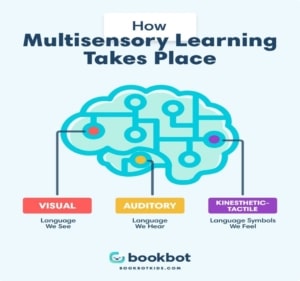What is Multisensory Instruction?
Multisensory instruction involves several senses such as touch, sight, and hearing. It is based on the belief that the best way to learn is to stimulate different areas of the brain. At the Colorado Reading Center, lessons usually include manipulatives. These tools encourage students to use their auditory, visual, and tactile-kinesthetic (touch/movement) senses to complete tasks. 
Science
Regions of our brains work together to process information. A multisensory approach to learning activates multiple brain areas at once, allowing information to be encoded reliably and retrieved quickly. Additionally, researchers propose that children have different learning styles. Instructors can tailor multisensory tasks to align with their students’ strengths.
Benefits of Multisensory Instruction
Studies show that children with stronger reading abilities have more interaction between brain regions. These findings indicate that reading involves the whole brain and requires different sensory processing centers to communicate with each other. Reading is a multisensory act: readers must link visual information (printed letters) with speech sounds. For this reason, multisensory learning can strengthen neural connections and, therefore, early literacy skills. This mode of instruction can also provide learners with alternative ways to absorb information as well as improve reading comprehension and critical thinking.
Sources:
- Multisensory Learning Strategies For Teaching Students How to Read – Waterford.org
- What are Multisensory Instruction Techniques for Teachers and Parents?Learning Center for children who learn differently, their teachers and parents in Dubai, Middle East (lexiconreadingcenter.org)
- Multi-Sensory Activities in the Classroom: 5 Activities to Use | IMSE – Journal

